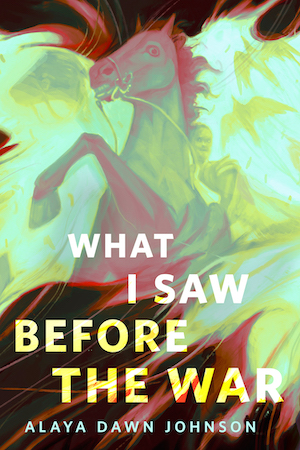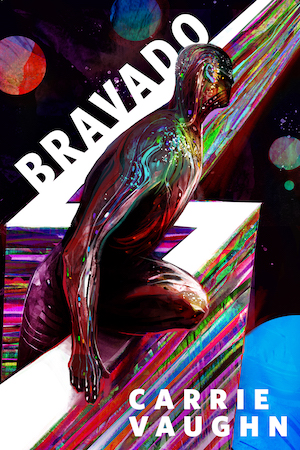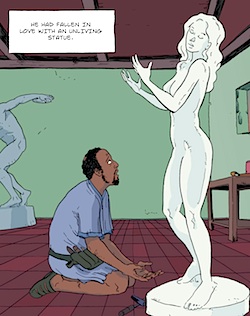Unfortunately, writing a book (Aphrodite: Goddess of Love) about the physical embodiment of the erotic power of the universe doesn’t exactly make me a love doctor, but creating a series of graphic novels about Greek mythology certainly has made my mortal mind the repository of something of an interesting collection of truly bizarre love stories.
Here are some of my favorites.
The Abduction of Persephone: This might seem a troubling story to include on a list of love stories (I mean, their ‘meet cute’ was a kidnapping). However I came across an interesting article while compiling research for my own retelling of this story in my book Hades: Lord of the Dead. The author of this article (and the article is, at least temporarily lost to time, apologies to him/her) points out, after the famous compromise that allowed Persephone to spend six months a year in the Underworld with her adductor/husband Hades and six months on Olympus with her mom Demeter, that there are no more stories featuring Persephone on Olympus. Hmm, that is interesting, I thought. There are many, many myths where she puts her time in as Queen of the Underworld, from appearances in the Odyssey and the stories of Heracles and Orpheus. Huh. So maybe an inordinate number of myths take place in the winter, when Persephone is stationed down under. Nope! Going by details such as mentions of specific flowering plants, weather and festivals, the author was able to determine that Persephone pretty much spends all year with Hades in the Underworld.
I coupled this info with the fact that Persephone wasn’t always called Persephone—before her abduction she was named Kore, or, essentially, ‘maiden.’ A lackluster name to be sure. After spending her initial stint in the Underworld, however, Kore rechristened herself Persephone, or ‘the Bringer of Destruction.’ Whoa, sounds like maybe she grew into her new role as the consort of Hades, and maybe liked it. I used all this as my basis for a retelling of the Abduction that starts out the same, but features a Persephone with a bit more agency in her fate than had previously been depicted.
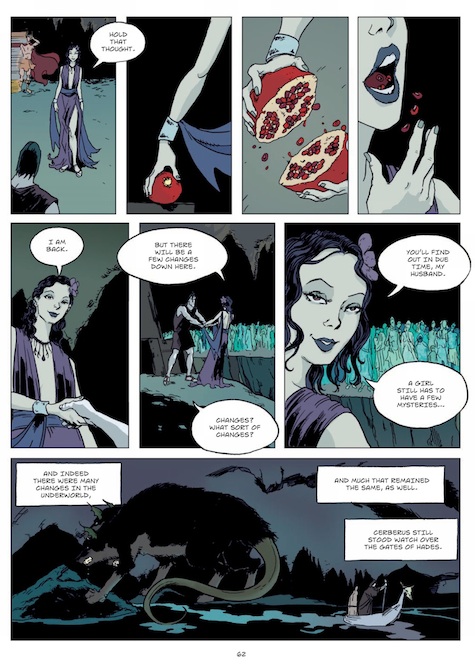
Pygmalion: This is a pretty well known story, and in short it goes like this: Pygmalion was a sculptor on the island of Cyprus, who created an ivory statue of a woman that was so beautiful he fell in love with it. In her temple, he prayed to the Goddess Aphrodite for a woman who looked just like his statue. The Goddess sussed out what Pygmalion really meant, and when he returned home from her temple, his statue miraculously came to life, and they were married and lived happily ever after.
Very sweet and romantic, no? And the subject and/or inspiration of many great works of art, from paintings to sculptures to plays to movies. It wasn’t until I actually sat down to adapt this story for Aphrodite that I realized how peculiar it actually is, and realized how much of the story is in the telling. Pygmalion falls in love with an unloving statue, presumably based on its physical properties alone (I can’t imagine the statue was a very good conversationalist). So really, Pygmalion was just a lonely guy who fantasized about a remote and unreachable woman. That’s not too strange. Until you read the parts about how he dressed and fed the statue (this is pre-enlifening, mind you) and then it can veer uncomfortably close into RealDoll type territory, and suddenly can seem as romantic as a scene from Mannequin 2: On the Move. I like to think my retellling avoided this fate, but I’ll let you be the judge.
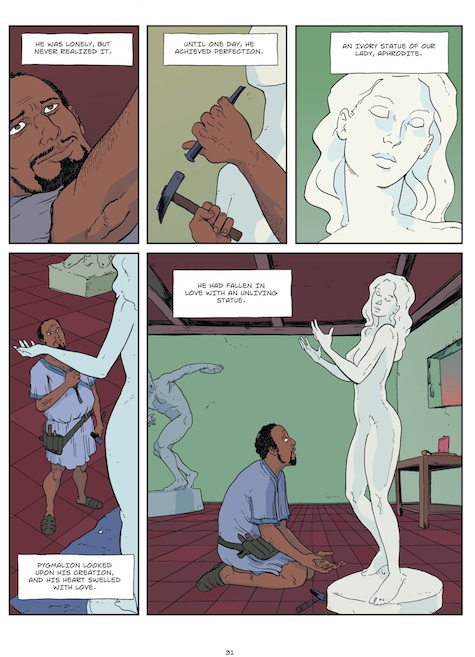
Pasiphae and the Bull of Minos: This one got a few chuckles from my editors. Everyone knows about the Minotaur, but strangely very few people stop to ask themselves from whence did this half-man, half-bull come? And that’s probably a very admirable act of self-preservation, because this is how: Poseidon, pleased with the affluence and worship of the island of Crete sent a majestic Bull from the Sea to their king, Minos. This gift was more of a loan, as it was meant to be sacrificed right back to the god, but this was a mighty fine animal, and Minos thought he’d keep it to improve the caliber of his cattle stock. He instead sacrificed another, non-fancy bull to Poseidon who, of course, wasn’t fooled for a second.
A good rule of thumb, if you ever find yourself in mythological Greece? Don’t mess with Poseidon.
Instead of, oh, say, wiping out the Minoan civilization with a tsunami (he’d do that later) Poseidon sent an ‘unnatural lust’ upon Minos’ queen, Pasiphae. For that Bull from the Sea. Oh yeah he did. Consumed with improper feeling for the Bull, Pasiphae enlisted a visiting Athenian inventor named Daedalus to construct a sort of robo-cow-suit for her so that she might visit with the Bull from the Sea and, well, I’ll leave that up to your imaginations. Nine months later, out came Asterion (that’s the Mintotaur’s real name) and the rest is history. For his part in aiding this strange affair, Daedalus was made to construct an enclosure for this bizarre cow-boy, and that’s how the Labyrinth was made.
Zeus and the Origin of the Myrmidons: Zeus, the player of Greek myth. Nearly every one of his myths, which are legion, involve his getting involved in some illicit affair. He’s had so many lovers that you get the feeling, while reading the corpus of his stories, that he’s just going through the motions of a serial cheater, that the thrill is gone. But Zeus is a wily one. This is a dude who proposed to his Queen, Hera, in the guise of a half-drowned cuckoo in order to most appeal to her sympathies. No, Zeus, no longer content with just wowing the nymphs and mortal princesses with his Zeusy awesomeness, starts taking on other forms for his seductions. Just to make it interesting.
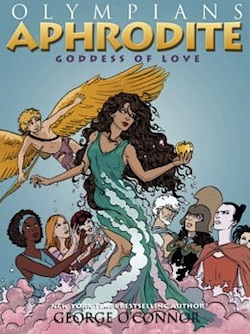 Let’s see, he seduces Europa, namesake of Europe, in the form of a bull. He seduces Leda, mom of Helen of Troy, in the form of a swan (and baby Helen was consequently born from an egg). Not much of a seduction, I suppose, but he carries off Ganymede in the form of an eagle. He gets a bit abstract with Danae, mom of Perseus, when he seduces her in the form of a shower of gold.
Let’s see, he seduces Europa, namesake of Europe, in the form of a bull. He seduces Leda, mom of Helen of Troy, in the form of a swan (and baby Helen was consequently born from an egg). Not much of a seduction, I suppose, but he carries off Ganymede in the form of an eagle. He gets a bit abstract with Danae, mom of Perseus, when he seduces her in the form of a shower of gold.
My favorite Zeus seduction story, however, is one I’ve just recently uncovered. I’ve just finished working on the upcoming Olympians volume 7, Ares: God of War, which tells in part of part of the Trojan War and the wrath of Achilles. Achilles is the king of the Myrmidons, a legendary tribe of warriors whose name I’ve always understood to mean something approximating ‘ant-people.’ How strange, thought I, and always assumed it was a reference to their armor, or the way they swarmed over their enemies.
You all know where this is going, right?
I did a little reading and, sure enough, on Achille’s father’s side, his great great great grandmother was seduced by Zeus… as an ant. I can’t even imagine the logistics of this act, and my knowledge of the story doesn’t go much beyond what I just recounted, so I‘ll just leave you with this stub. Rest assured, I will be researching this, and you shouldn’t be surprised if this story ends up in a future volume of Olympians.
George O’Connor is the author of Aphrodite: Goddess of Love, a graphic novel adaptation of the classic Greek myths. Aphrodite is sixth in the New York Times Best-Selling Olympians series.


